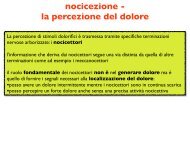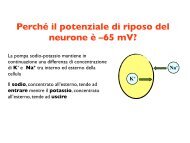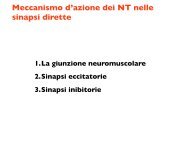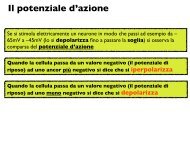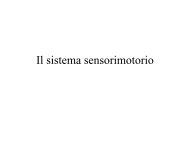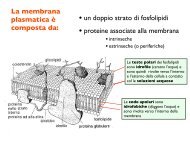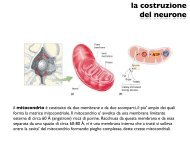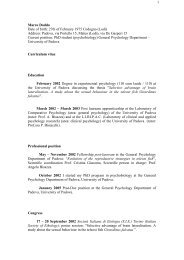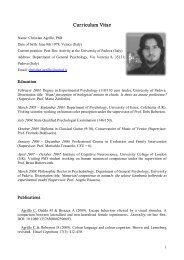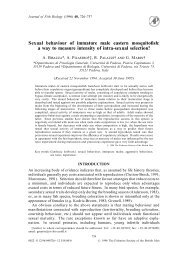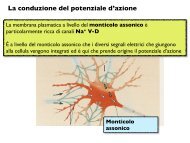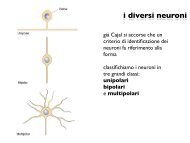Visual lateralization in response to familiar and unfamiliar ... - CPRG
Visual lateralization in response to familiar and unfamiliar ... - CPRG
Visual lateralization in response to familiar and unfamiliar ... - CPRG
Create successful ePaper yourself
Turn your PDF publications into a flip-book with our unique Google optimized e-Paper software.
390 V.A. Sovrano / Behavioural Bra<strong>in</strong> Research 152 (2004) 385–391<br />
not true for artificial stimuli. The only way <strong>to</strong> check for any<br />
special status of social stimuli would be hatch<strong>in</strong>g <strong>and</strong> rear<strong>in</strong>g<br />
fish deprived of any experience with members of their<br />
own species. However, consider<strong>in</strong>g that accord<strong>in</strong>g <strong>to</strong> some<br />
hypotheses [4,14,15,21] there would be a strict l<strong>in</strong>k between<br />
the development of directional <strong>lateralization</strong> <strong>and</strong> sociality,<br />
these sort of experiments may present serious difficulties of<br />
<strong>in</strong>terpretation because such animals would be socially abnormal<br />
<strong>in</strong> several respects.<br />
A possible <strong>in</strong>terpretation of the behaviour exhibited by<br />
fish <strong>in</strong> these tasks is that, once the animals are placed <strong>in</strong> the<br />
novel environment, the test-tank, they tend <strong>to</strong> orient <strong>in</strong> such<br />
a way that the left eye is used <strong>to</strong> moni<strong>to</strong>r the <strong>familiar</strong> part of<br />
the environment, possibly leav<strong>in</strong>g the right eye <strong>to</strong> scrut<strong>in</strong>ise<br />
for potentially dangerous stimuli. This would be consistent<br />
with the fact that only a slight right-eye bias was observed,<br />
after the first 5 m<strong>in</strong>, <strong>in</strong> Experiment 2 us<strong>in</strong>g un<strong>familiar</strong> stimuli.<br />
This outcome is consistent with evidence that the right eye<br />
is preferentially used <strong>to</strong> scrut<strong>in</strong>y potentially noxious stimuli,<br />
such as a preda<strong>to</strong>r [8]. When located <strong>in</strong> the test-tank with the<br />
un<strong>familiar</strong> stripes orientation, at the start fish probably do<br />
not have any clear reason <strong>to</strong> orient their right eye <strong>to</strong>wards the<br />
stripes, because these are novel but so also is the rest of the<br />
environment; only after some m<strong>in</strong>utes they turn <strong>to</strong> use their<br />
right eye <strong>to</strong>wards the stripes, but the bias rema<strong>in</strong>ed slight,<br />
probably because this stimulus is <strong>in</strong> any case a simple variation<br />
of a <strong>familiar</strong> stimulus, not a really fear-<strong>in</strong>duc<strong>in</strong>g one.<br />
Interest<strong>in</strong>gly, these data bear some resemblance with the<br />
<strong>lateralization</strong> pattern that has been observed <strong>in</strong> young domestic<br />
chicks, the only other species <strong>in</strong> which <strong>response</strong> <strong>to</strong><br />
<strong>familiar</strong> <strong>and</strong> un<strong>familiar</strong> stimuli has been tested with both<br />
natural <strong>and</strong> artificial stimuli [1,20,22]. Basically, chicks<br />
use their left eye preferentially when look<strong>in</strong>g at <strong>familiar</strong> or<br />
slightly novel highly <strong>familiar</strong> stimuli (e.g. impr<strong>in</strong>t<strong>in</strong>g objects),<br />
but turn <strong>to</strong> right eye use when view<strong>in</strong>g large novelty.<br />
Data from chicks <strong>and</strong> other species of fish may thus suggest<br />
even another, more analytical account of our f<strong>in</strong>d<strong>in</strong>gs.<br />
On Experiment 2 the <strong>in</strong>teraction time by test conditions appears<br />
<strong>to</strong> be generated by change <strong>in</strong> the group view<strong>in</strong>g a<br />
<strong>familiar</strong> pattern from left- <strong>to</strong> right-eye bias <strong>and</strong> then <strong>to</strong> no<br />
bias, whilst the group see<strong>in</strong>g the un<strong>familiar</strong> pattern does not<br />
change from slight right-eye bias. The first pattern is particularly<br />
important, s<strong>in</strong>ce it has not previously been found,<br />
probably because <strong>in</strong>sufficiently long exposures have been<br />
studied. It suggests an <strong>in</strong>itial left-eye <strong>in</strong>volvement <strong>in</strong> establishment<br />
of identity, followed by a brief period when<br />
right-eye use is called for. Why might this be? A possible<br />
clue arises from work on another fish species, the zebrafish.<br />
Miklosi <strong>and</strong> Andrew [11] found that <strong>in</strong> zebrafish right-eye<br />
use went with visual control of <strong>response</strong> (e.g. when zebrafish<br />
were about <strong>to</strong> approach <strong>and</strong> bite a target). Right-eye<br />
use when view<strong>in</strong>g a preda<strong>to</strong>r [8] can be similarly expla<strong>in</strong>ed:<br />
aga<strong>in</strong> the fish is ready <strong>to</strong> perform a <strong>response</strong> (escape) whilst<br />
view<strong>in</strong>g the object that may evoke the <strong>response</strong>. The use of<br />
the left eye with small transformations of a <strong>familiar</strong> object<br />
[22] agrees with the data for fish (here <strong>and</strong> <strong>in</strong> references<br />
cited). The <strong>in</strong>itial use of the left eye <strong>to</strong> scrut<strong>in</strong>ise the <strong>familiar</strong><br />
stripes could be associated thus with the be establishment<br />
of identity, followed by a brief period when some sort of<br />
<strong>response</strong> is likely.<br />
As noted above we cannot discard the possibility that the<br />
stimuli provided by a natural conspecific would be somewhat<br />
special <strong>in</strong> elicit<strong>in</strong>g a stronger lateral bias; however, at<br />
present, the most parsimonious <strong>in</strong>terpretation of the data is<br />
that the preferential use of the left monocular visual field is<br />
associated with establishment of identity of <strong>familiar</strong> stimuli,<br />
either social or not social.<br />
Acknowledgements<br />
I thank Professors Angelo Bisazza <strong>and</strong> Giorgio Vallortigara<br />
<strong>and</strong> two anonymous reviewers for thoughtful comments<br />
on the manuscript, <strong>and</strong> Marco Dadda for help with care of<br />
the animals’ <strong>and</strong> preparation of the stimuli.<br />
References<br />
[1] Andrew RJ. The nature of behavioural <strong>lateralization</strong> <strong>in</strong> the chick. In:<br />
Andrew RJ, edi<strong>to</strong>r. Neural <strong>and</strong> behavioural plasticity. The use of the<br />
chick as a model. Oxford: Oxford University Press; 1991. p. 536–54.<br />
[2] Bisazza A, Pignatti R, Vallortigara G. De<strong>to</strong>ur tests reveal task<strong>and</strong><br />
stimulus-specific neural <strong>lateralization</strong> <strong>in</strong> mosqui<strong>to</strong>fish (Gambusia<br />
holbrooki). Behav Bra<strong>in</strong> Res 1997;89:237–42.<br />
[3] Bisazza A, Pignatti R, Vallortigara G. Laterality <strong>in</strong> de<strong>to</strong>ur behaviour:<br />
<strong>in</strong>terspecific variation <strong>in</strong> poeciliid fish. Anim Behav 1997;54:1273–<br />
81.<br />
[4] Bisazza A, Cantalupo C, Capocchiano M, Vallortigara G. Population<br />
<strong>lateralization</strong> <strong>and</strong> social behaviour: a study with sixteen species of<br />
fish. Laterality 2000;5:269–84.<br />
[5] Bisazza A, De Santi A, Bonso S, Sovrano VA. Frogs <strong>and</strong> <strong>to</strong>ads<br />
<strong>in</strong> front of a mirror: lateralisation of <strong>response</strong> <strong>to</strong> social stimuli <strong>in</strong><br />
tadpoles of five anuran species. Behav Bra<strong>in</strong> Res 2002;134:417–24.<br />
[6] Broad KD, Mimmack ML, Kendrick KM. Is right hemisphere specialization<br />
for face discrim<strong>in</strong>ation specific <strong>to</strong> humans? Europ J Neurosci<br />
2000;12:731–41.<br />
[7] Dadda M, Sovrano VA, Bisazza A. Temporal pattern of social aggregation<br />
<strong>and</strong> its <strong>in</strong>fluence on the measurement of lateralized <strong>response</strong><br />
<strong>to</strong> social stimuli. Physiol Behav 2003;78:337–41.<br />
[8] De Santi A, Sovrano VA, Bisazza A, Vallortigara G. Mosqui<strong>to</strong>fish display<br />
differential left- <strong>and</strong> right-eye use dur<strong>in</strong>g mirror-image scrut<strong>in</strong>y<br />
<strong>and</strong> preda<strong>to</strong>r-<strong>in</strong>spection <strong>response</strong>s. Anim Behav 2001;61:305–10.<br />
[9] Gamse JT, Thisse C, Thisse B, Halpern ME. The parap<strong>in</strong>eal mediates<br />
left-right asymmetry <strong>in</strong> the zebrafish diencephalons. Development<br />
2003;130:1059–68.<br />
[10] Heuts BA. Lateralization of trunk muscle volume, <strong>and</strong> <strong>lateralization</strong><br />
of swimm<strong>in</strong>g turns of fish respond<strong>in</strong>g <strong>to</strong> external stimuli. Behav<br />
Process 1999;47:113–24.<br />
[11] Miklosi A, Andrew RJ. Right eye use associated with decision <strong>to</strong><br />
bite <strong>in</strong> zebrafish. Behav Bra<strong>in</strong> Res 1999;105:199–205.<br />
[12] Miklosi A, Andrew RJ, Savage H. Behavioural lateralisation of the<br />
tetrapod type <strong>in</strong> the zebrafish (Brachydanio rerio). Physiol Behav<br />
1998;63:127–35.<br />
[13] Peirce JW, Leigh AE, Kendrick KM. Configurational cod<strong>in</strong>g, <strong>familiar</strong>ity<br />
<strong>and</strong> the right hemisphere advantage for face recognition <strong>in</strong><br />
sheep. Neuropsychologia 2000;38:475–83.<br />
[14] Rogers LJ. Laterality <strong>in</strong> animals. Int J Comp Psychol 1989;3:5–25.



